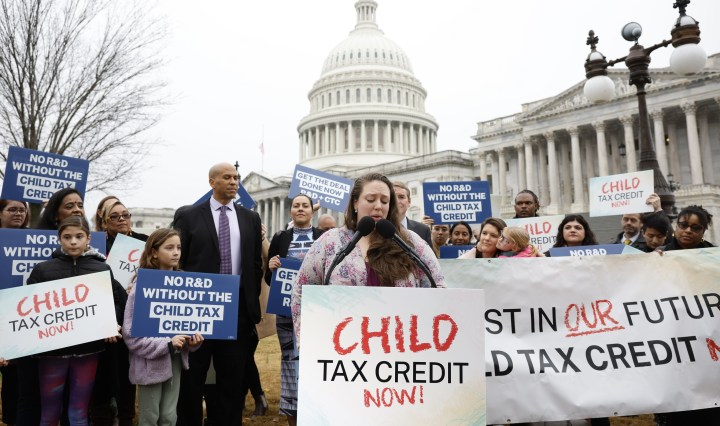
Here’s what’s in the new bill to expand the child tax credit
Share Now on:
Here’s what’s in the new bill to expand the child tax credit

Federal lawmakers have proposed a $78 billion bipartisan bill that enhances the child tax credit by providing more generous benefits to parents, a move that could lift nearly half a million children out of poverty in the first year.
Democratic Sen. Ron Wyden of Oregon, who announced the bill with Republican House member Jason Smith of Missouri, said that the bill will help working families.
The Center on Budget and Policy Priorities, a nonpartisan think tank, noted that the bill will benefit 16 million children. However, the CBPP noted that it’s smaller than the expanded child tax credit, which provided monthly checks to families and ended in 2021. This new bill does not call for the IRS to distribute monthly checks to those who qualify. Once the expanded credit ended, families continued to receive their tax credit all at once when they filed taxes.
While President Joe Biden wanted to permanently extend the 2021 credit, it faced resistance from Republicans and Democratic Sen. Joe Manchin, who called for the credit to have a “firm work requirement.” The new bipartisan bill includes tax breaks for businesses to appease Republicans, but outlets such as the New York Times and the Wall Street Journal report that it will have trouble passing in Congress.
If the bill ends up getting signed into law, here’s what it would include:
What’s the current child tax credit and what will change?
Currently, you can claim the child tax credit for the 2023 tax year, which provides a maximum of $2,000 per child, when you file a tax return this year, according to the Internal Revenue Service. You get the $2,000 if you’re a married couple filing jointly and making under $400,000, while the threshold for other filers is $200,000.
If your modified adjusted gross income is above those thresholds, your credit will decline by $50 for every $1,000 you make above the limit. Each child has to be under the age of 17 and families must earn at least $2,500 a year or have at least three qualifying dependents.
While the maximum child tax credit per child is $2,000, the refundable portion of this credit is capped at $1,600. A refundable tax credit means you can get that amount if it exceeds the amount of tax that you owe, according to the Internal Revenue Service. The new bill raises the maximum refundable amount to $1,800 for the 2023 tax year, $1,900 in 2024, and $2,000 in 2025.
Here’s one example from the Bipartisan Policy Center: Say a married couple that makes $30,000 is filing jointly and they owe $230 in federal income taxes. If they have two children, their child tax credit amount is $4,000. They can offset that $230, which brings the amount down to $3,770, or $1,885 per child. But because the refundable amount is capped at $1,600 per child, the refundable amount they get is only $3,200.
Right now, your maximum refundable child tax credit is calculated by multiplying any earned income above $2,500 by 15%. But the calculation outlined in the new bill would multiply your earned income by 15%, then multiply that by the amount of qualifying children you have. This would be in effect for the 2023, 2024 and 2025 tax years.
According to the CPBB, a single parent with two children who makes $13,000 a year currently qualifies for a credit of $1,575.That’s because $13,000 minus $2,500 equals $10,050. Multiply that by 15% and you end up with $1,575. The new bill would give that parent $1,575 per child, or a total of $3,150.
For the 2024 and 2025 tax years, families under the new bill would also be able to use earned income from the previous year to calculate the maximum child tax credit. This will benefit those whose earned income in the current year is less than their earned income the previous year.
How expanded child tax credit benefits can help families
The American Rescue Plan Act of 2021 temporarily expanded the already-existing child tax credit, providing eligible families with up to $300 per month for each child under the age of 6, or a max of $3,600 a year per child. Eligible families with children above the age of 6 received up to $250 each month, or a maximum of $3,000 per child.
At the time, experts hailed the expanded tax credit as “ambitious” and expressed excitement that more families would receive additional aid.
This expanded tax credit allowed families to qualify even if they had no income and claim children as dependents if they were under the age of 18 instead of 17.
But these expanded benefits ended at the end of 2021. Marketplace’s Amanda Peacher reported that families depended on these additional payments, spending them on basic necessities — gas, groceries, rent, utilities.
The poverty rate for children ended up rising from 5.2% in 2021 — a historic low — to 12.4% in 2022, according to data from the U.S. Census Bureau. Columbia University’s Center on Poverty and Social Policy conducted an analysis that found the child poverty rate would have stood at 8.1% if the expanded Child Tax Credit had not expired.
There’s a lot happening in the world. Through it all, Marketplace is here for you.
You rely on Marketplace to break down the world’s events and tell you how it affects you in a fact-based, approachable way. We rely on your financial support to keep making that possible.
Your donation today powers the independent journalism that you rely on. For just $5/month, you can help sustain Marketplace so we can keep reporting on the things that matter to you.


















